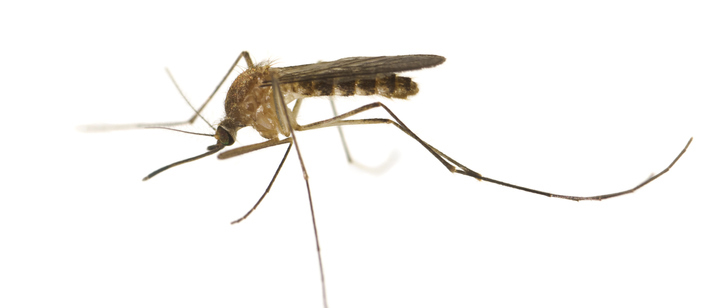Encyclopedia Dubuque
"Encyclopedia Dubuque is the online authority for all things Dubuque, written by the people who know the city best.”
Marshall Cohen—researcher and producer, CNN
Affiliated with the Local History Network of the State Historical Society of Iowa, and the Iowa Museum Association.
WEST NILE VIRUS
WEST NILE VIRUS. West Nile virus (WNV) is the leading cause of mosquito-borne disease in the continental United States. It is most commonly spread to people by the bite of infected MOSQUITOES. Cases of WNV occur during mosquito season, which starts in the summer and continues through fall.
Most people (8 out of 10) infected with West Nile virus do not develop any symptoms. About 1 in 5 people who are infected develop a fever with other symptoms such as headache, body aches, joint pains, vomiting, diarrhea, or rash. Most people with fever due to West Nile virus recover completely, but fatigue and weakness can last for weeks or months.
Serious symptoms occur in a few people. Symptoms of severe illness include high fever, headache, neck stiffness, stupor, disorientation, coma, tremors, convulsions, muscle weakness, vision loss, numbness and paralysis. About 1 in 150 people who are infected develop a severe illness affecting the central nervous system such as encephalitis (inflammation of the brain) or meningitis (inflammation of the membranes that surround the brain and spinal cord).
Severe illness can occur in people of any age. People over 60 years of age are at greater risk for severe illness if they are infected (1 in 50 people). People with certain medical conditions, such as cancer, diabetes, hypertension, kidney disease, and people who have received organ transplants, are also at greater risk.
There are no vaccines to prevent or medications to treat WNV in people. Recovery from severe illness might take several weeks or months. Some effects to the central nervous system might be permanent. You can reduce your risk of WNV by using insect repellent and wearing long-sleeved shirts and long pants to prevent mosquito bites. (1)
In 1999 New York City had the first recognized cases of the illness. By 2000 it was found in New York, Maryland, New Jersey, Connecticut and Massachusetts. The mosquitos which spread the disease also lived in Iowa leading to the search in 2000 for dead crows in the Hawkeye State. Brains from the birds were sent to Iowa State University for testing. Chicken flocks in the state were also monitored for signs of the disease. (2) The first human cases of West Nile in Iowa were reported in 2001. (3)
By 2002 nine people had died of the virus since it was first discovered in the United States in 1999. There were 66 cases in the nation in 2001 with most in the eastern states. (4)
Trapping culex mosquitos, the variety associated with West Nile, became standard practice by 2003. By comparing the numbers collected annually, the risk of the virus being present could be judged. In June, 2003 local traps collected 29 culex mosquitos compared to 9 the previous year. City health officials produced a West Nile virus pamphlet stating that less than 1 percent of mosquitos were infected and less than one percent of those bitten by an infected mosquito would become seriously ill. Suggestions were made to eliminate standing water around homes. (5)
The first confirmed Dubuque resident to contract the virus was Nathan Shaw who may have been bitten by a mosquito while living in Iowa City in October, 2003. He recovered. In 2002 the state registered 54 cases and two fatalities. In 2003 there were 128 cases ad four fatalities. (6)
By 2005 the first cases of Equine West Nile Virus were found in horses in Wisconsin. Veterinarians in the state were warning that vaccination of horses were needed. In addition, twenty-seven birds and two humans had been found with the disease. (7)
By 2008 it was recognized that the number of Iowans infected with the virus tended to increase in September and into October if the weather stayed nice. Being outside until the first hard frost meant a person ran the risk of getting the disease. (8)
Human cases in Iowa have been reported every year since 2002. (9)
---
Source:
1. "West Nile Virus," Centers for Disease Control and Prevention, Online: https://www.cdc.gov/westnile/index.html and https://www.cdc.gov/westnile/symptoms/index.html
2. "State Searches for Evidence of West Nile Virus," Telegraph Herald, August 9, 2000, p. 5
3. "Fewer Human Cases of West Nile in State," Telegraph Herald, September 1, 2006
4. "West Nile Virus Found in 11 Counties," Telegraph Herald, August 2, 2002, p. 10
5. Hogstrom, Erik, "Culex Mosquitos Found," Telegraph Herald, July 3, 2003, p. 1
6. Hogstrom, Erik, "West Nile Strikes Teen," Telegraph Herald, October 15, 2003, p. 1
7. "Horses at Risk for West Nile Virus," Telegraph Herald, September 18, 2005. p. 1
8. "Man in Western Iowa Dies of West Nile Virus," Telegraph Herald, September 18, 2008, p. 3
9. "West Nile Virus," Iowa Department of Public Health, Online:https://idph.iowa.gov/cade/disease-information/west-nile-virus


